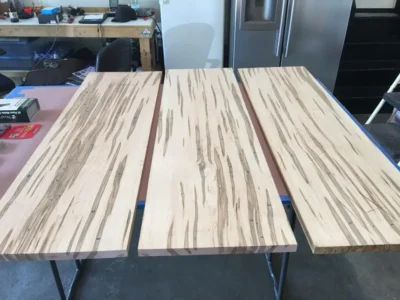
Ambrosia maple wood is a special and interesting type of wood. It has become popular with woodworkers, furniture makers, and interior designers. Its distinctive appearance and fascinating history make it a subject of interest for both professionals and enthusiasts. This article delves into the world of maple ambrosia, exploring its characteristics, uses, and the ecological role it plays.
Table of Contents
What is Ambrosia Maple Wood?
Ambrosia maple is not a specific type of maple tree. It is a term for maple wood that has been infested by the ambrosia beetle. The beetle bores into the tree, introducing a fungus that causes discoloration and unique patterns in the wood. These patterns, often resembling clouds or streaks, are what make ambrosia maple so sought after.
Characteristics of Ambrosia Maple
-Color and Patterns: The wood has a light base color. It is usually creamy white or pale yellow. You can see streaks of gray, brown, or black. These streaks are the result of the fungus introduced by the ambrosia beetle.
-Texture: Ambrosia maple has a fine, even texture with a natural luster, making it ideal for finishing and polishing.
-Hardness: It is relatively hard and durable, similar to other types of maple, which makes it suitable for various applications.
Ambrosia beetles play a crucial role in forest ecosystems. They belong to a group of insects called wood-boring beetles. These beetles help break down dead or dying trees. This process returns nutrients to the soil. While their activity can be detrimental to living trees, they are essential for maintaining the health of forests.
The Symbiotic Relationship
-Beetles and Fungus: The ambrosia beetle and the fungus it carries have a symbiotic relationship. The beetle provides a habitat for the fungus, while the fungus serves as a food source for the beetle larvae.
-Impact on Trees: The beetles mainly attack stressed or weak trees. However, they can sometimes infest healthy trees too. This leads to the unique patterns found in ambrosia maple.

Uses of Ambrosia Maple
Ambrosia maple is prized for its aesthetic appeal and is used in a variety of applications. Its unique appearance makes it a favorite among artisans and designers.
Furniture and Cabinetry
-Tables and Chairs: The striking patterns of maple ambrosia make it an excellent choice for crafting eye-catching tables and chairs.
-Cabinetry: Its durability and beauty make it ideal for custom cabinetry, adding a touch of elegance to kitchens and bathrooms.
Musical Instruments
–Guitars: Luthiers often use ambrosia maple wood for guitar bodies and necks, as its unique appearance adds visual interest to the instrument.
-Violins and Cellos: The wood’s tonal qualities and aesthetic appeal make it a popular choice for string instruments.
Decorative Items
-Bowls and Vases: Woodturners appreciate maple ambrosia for creating decorative bowls and vases, where the wood’s patterns can be showcased.
–Wall Art: Artists use ambrosia maple to create stunning wall art pieces, highlighting the natural beauty of the wood.
Case Studies: Maple Ambrosia in Action
Case Study 1: Custom Furniture Design
A renowned furniture designer, John Smith, incorporated ambrosia maple into his latest collection. He used the wood’s natural patterns to make tables and chairs. They became the main focus of his exhibition. The collection received rave reviews for its innovative use of materials and unique aesthetic.
Case Study 2: Sustainable Woodworking
A small woodworking company, GreenCraft, focuses on sustainable practices by using locally sourced ambrosia maple. They use wood from trees that would be thrown away because of beetle damage. This way, they make beautiful, eco-friendly products. Their approach not only reduces waste but also supports local ecosystems.
The Market for Ambrosia Maple Wood
The demand for ambrosia maple has grown significantly in recent years, driven by its unique appearance and versatility. As more artisans and designers discover its potential, the market continues to expand.
Statistics and Trends
-Rising Popularity: According to industry reports, the use of ambrosia maple lumber in furniture and interior design has increased by 20% over the past five years.
– Price Trends: The price of maple ambrosia has seen a steady rise, reflecting its growing demand and limited supply.
Conclusion
Ambrosia maple is a testament to nature’s ability to transform adversity into beauty. Its unique patterns come from the close relationship between beetles and fungi. This makes it a valuable material in many industries. From furniture to musical instruments, maple ambrosia offers endless possibilities for creativity and innovation. As people learn more about its ecological and aesthetic value, its role in design and craftsmanship is also growing.
In summary, maple ambrosia is not just a kind of wood. It tells a story of change and strength. Its journey from the forest to the finished product shows the connections in our ecosystems. It also highlights the beauty that can come from them.
FAQs
Is Ambrosia Maple Good for Cutting Boards?
Ambrosia maple can be used for cutting boards. However, it is not as good as other types of maple. This is because it may have softer spots from fungal staining. Also, the porous areas can be harder to clean. This makes it less hygienic for food preparation than harder maples, like hard rock maple.
How to Finish Ambrosia Maple?
To finish ambrosia maple:
– Sand the surface smoothly, starting with coarse grit and moving to fine grit.
– Apply a clear finish like polyurethane, oil, or lacquer to highlight the natural grain and color variations.
– For cutting boards or food-safe items, use a food-grade mineral oil or beeswax finish instead of chemical sealants.
Is Ambrosia Maple a Hardwood?
Yes, ambrosia maple is classified as a hardwood because it comes from deciduous maple trees. The areas affected by the ambrosia beetle may have softer spots. This depends on how much fungal staining there is.


